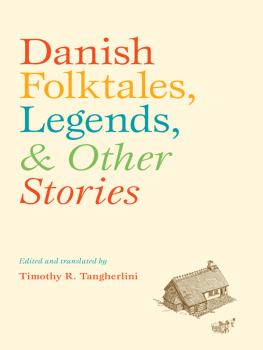
NEW DIRECTIONS IN SCANDINAVIAN STUDIES
TERJE LEIREN AND CHRISTINE INGEBRITSEN, SERIES EDITORS
NEW DIRECTIONS IN SCANDINAVIAN STUDIES
This series offers interdisciplinary approaches to the study of the Nordic region of Scandinavia and the Baltic States and their cultural connections in North America. By redefining the boundaries of Scandinavian studies to include the Baltic States and Scandinavian America, the series presents books that focus on the study of the culture, history, literature, and politics of the North.
Small States in International Relations edited by
Christine Ingebritsen, Iver B. Neumann, Sieglinde Gstohl, and Jessica Beyer
Danish Cookbooks: Domesticity and National Identity, 16161901
Carol Gold
Crime and Fantasy in Scandinavia: Fiction, Film, and Social Change
Andrew Nestingen
Selected Plays of Marcus Thrane translated and introduced by
Terje I. Leiren
Munch's Ibsen: A Painter's Visions of a Playwright
Joan Templeton
Knut Hamsun: The Dark Side of Literary Brilliance
Monika agar
Nordic Exposures: Scandinavian Identities in Classical Hollywood Cinema
Arne Lunde
Icons of Danish Modernity: Georg Brandes and Asta Nielsen
Julie K. Allen
Danish Folktales, Legends, and Other Stories
Timothy R. Tangherlini
Icons of Danish Modernity
GEORG BRANDES AND ASTA NIELSEN
Julie K. Allen
UNIVERSITY OF WASHINGTON PRESS
Seattle and London
MUSEUM TUSCULANUM PRESS
Copenhagen
THIS BOOK IS MADE POSSIBLE BY A COLLABORATIVE GRANT FROM THE ANDREW W. MELLON FOUNDATION.
This publication is supported by a grant from the Scandinavian Studies Publication Fund.
2012 by the University of Washington Press
17 16 15 14 13 12 5 4 3 2 1
All rights reserved. No part of this publication may be reproduced or transmitted in any form or by any means, electronic or mechanical, including photocopy, recording, or any information storage or retrieval system, without permission in writing from the publisher.
University of Washington Press
PO Box 50096, Seattle, WA 98145, USA
www.washington.edu/uwpress
Published in Europe by Museum Tusculanum Press
126 Njalsgade, DK-2300 Copenhagen S, Denmark
www.mtp.dk ISBN 978-87-635-3978-4
Library of Congress Cataloging-in-Publication Data
Allen, Julie K.
Icons of Danish modernity : Georg Brandes and Asta Nielsen / Julie K. Allen.
p. cm. (New directions in Scandinavian studies)
ISBN 978-0-295-99220-4 (hardback)
1. Brandes, Georg, 18421927Criticism and interpretation. 2. Brandes, Georg, 18421927Friends and associates. 3. Nielsen, Asta, 18811972Friends and associates. 4. DenmarkCivilization20th century. 5. DenmarkIntellectual life20th century. 6. National characteristics, Scandinavia. I. Title.
PT8125.B8Z6125 2012
306.09489dc23 2012018870
The paper used in this publication is acid-free and meets the minimum requirements of American National Standard for Information SciencesPermanence of Paper for Printed Library Materials, ANSI Z39.48 1984.
ISBN-13: 978-0-295-80436-1 (electronic)
To Brent, who may not have realized what an odyssey he was signing up for but has been an incomparable traveling companion all the same.
PREFACE
Whenever I mention this project to Danes, the most common initial response I get is the surprised query, Georg Brandes and Asta Nielsen together? The eminent scholar Jrgen Knudsen, who has written more about Brandes than anyone in the world, exclaimed, Well, that's going to be a very short book! As these comments suggest, my decision to pair the cantankerous literary and social critic Brandes with the glamorous silent film diva Nielsen may not, at first glance, seem intuitive or substantial enough to justify an entire book on the subject. I am convinced, however, that the parallels between Brandes's and Nielsen's lives and works emerge quite clearly upon closer investigation, particularly when viewed through the theoretical lenses of celebrity power and metacultural influence. It is common knowledge that Brandes and Nielsen were pioneers in their respective professional fields, but very few people, especially in the English-speaking world, are aware either that their personal lives were intertwined or that their celebrity personas are closely connected to contemporary and ongoing discourses of Danish national identity construction and social liberalization.
My own path to this realization was fairly circuitous, starting in German literature and ending in Danish film. I first began researching Brandes's role in the marketing of Scandinavian literature in Germany in connection with my doctoral dissertation, which dealt with depictions of Denmark in German and Austrian literature of the late nineteenth and early twentieth centuries. I had not intended to write an entire chapter about Brandes, but his larger-than-life stature among the German-speaking authors of the time gave me little choice. His name cropped up everywhere, in widely disparate contexts, and nearly everyone I read about had a strong opinion about him. Regardless of whether they loved him or hated him, everyone who was anyone in northern European intellectual life at the end of the nineteenth century knew Brandes. When I began studying Nielsen several years later, I encountered the same phenomenon. She was ever-present in early German cinema, her name uttered with reverence by critics from Willy Haas to Siegfried Kracauer. The more I learned about these two brilliant, controversial individuals, the more I came to regard them as a team, working for a common cause, despite the differences between them. The sheer scale of Brandes's and Nielsen's international celebrity placed them in a category of their own among Danes of the time and demonstrated conclusively their representative function for their country and their culture in the world. Yet at the same time, the fact that their countrymen had such a hard time accepting them made it clear that their iconic status was contested at home, posing an irresistible riddle. This book is an attempt to solve that riddle by considering the similarities in the modernist orientation of their works, their fame abroad and conflicted reception at home, and, finally, their significance within the context of some of the larger social trends and issues that were at work in late-nineteenth and early twentieth-century European and American society.
ACKNOWLEDGMENTS
This book has been a long time in the making and I have received a tremendous amount of assistance and encouragement along the way. There are not worlds enough or time to thank everyone who deserves my thanks, so I ask forgiveness in advance for any omissions. When I started researching Georg Brandes while a graduate student in the department of Germanic Languages and Literatures at Harvard University, I benefited from the constructive criticisms of many distinguished scholars, including my doctoral advisors Maria Tatar, Judith Ryan, and Stephen Mitchell. I am deeply indebted to Per Dahl at Aarhus University, Denmark, for inviting me to spend 20022003 working in the Brandes Archive and for the many years of mentoring and hospitality that his initial invitation led to, as well as to his colleagues in the Institut for Litteraturhistorie at Aarhus University and to Olav Harslf at Roskilde University, Denmark, for their excellent advice and insights into Danish culture, literature, and politics. Among my many helpful colleagues at the University of WisconsinMadison, I must particularly thank Susan Brantly, Tanya Thresher, Tom DuBois, Scott Mellor, Kirsten Wolf, Nete Schmidt, Peggy Hager, Jim Leary, and especially Judy Anderson for boundless professional and personal support. I would also like to thank Marc Silberman, Jrgen Knudsen, Colin Cameron, Jennifer Black, Jillana Peterson, and Claire Thomson for their very helpful feedback on various drafts of this book, as well as the editors and anonymous reviewers at the University of Washington Press and the Modern Language Initiative who have so ably shepherded my manuscript all the way to publication.










